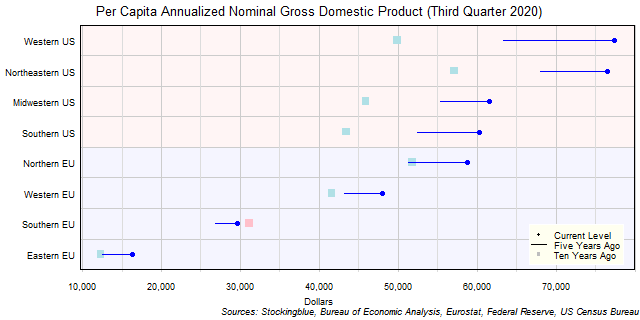
The chart above shows the per capita annualized nominal gross domestic product (GDP) in each EU and US region as of the third quarter of 2020 in US dollars, the change from five years ago, and the per capita GDP ten years prior. Only one EU region has seen a drop in per capita GDP over the past five or ten years.
Findings
- The difference between the region with the largest per capita GDP, the Western US, and the region with the smallest, the Eastern EU, is $61,052.57 (up from $55,609.61 five years ago and up from $44,740.36 ten years ago). The Northeastern US had the largest per capita GDP both five and ten years ago. The Eastern EU had the smallest per capita GDP both five and ten years ago.
- The Western US has 4.74 times the per capita GDP that the Eastern EU does. The ratio of largest per capita GDP to smallest per capita GDP went down from 5.46 five years ago and up from 4.62 ten years ago.
- Of the eight regions, eight (4 EU, 4 US) had a per capita GDP rise in current dollars over the past five years while zero (0 EU, 0 US) had a per capita GDP drop.
- Of the eight regions, seven (3 EU, 4 US) had a per capita GDP rise in current dollars over the past ten years while one (1 EU, 0 US) had a per capita GDP drop.
- The EU drop in per capita GDP is attributed to currency rate fluctuations.
Caveats
- GDP data is from the third quarters of 2010, 2015, and 2020.
- US census data is from 2000 and 2010; EU census data is from 2001 and 2011.
- The data is seasonally adjusted in current dollars.
- Euros are converted to dollars at an average exchange rate of 1.17 for the third quarter of 2020, 1.11 for the third quarter of 2015, and 1.29 for the third quarter of 2010 according to historic rates listed at the Federal Reserve (see source link below).
- US data comes in an annualized format which the EU does not, thus EU data is annualized by multiplying the quarterly figure by four.
- US growth rates may differ from those provided by the Bureau of Economic Analysis as the BEA's growth rates are based on chained dollars in conjunction with the chain index or the quality index for real GDP. The growth rates listed here are based on nominal GDP.
- All figures are rounded to the nearest hundredth.
- The Eastern EU consists of Poland, Czech Republic, Romania, Hungary, Slovakia, Bulgaria, Croatia, Slovenia, Lithuania, Latvia, and Estonia.
- The Midwestern US consists of Illinois, Ohio, Michigan, Indiana, Minnesota, Wisconsin, Missouri, Iowa, Kansas, Nebraska, North Dakota, and South Dakota.
- The Northeastern US consists of New York, Pennsylvania, New Jersey, Massachusetts, Maryland, Connecticut, New Hampshire, Delaware, Maine, Rhode Island, and Vermont.
- The Northern EU consists of Sweden, Denmark, and Finland.
- The Southern EU consists of Italy, Spain, Portugal, Greece, Cyprus, and Malta.
- The Southern US consists of Texas, Florida, Georgia, North Carolina, Virginia, Tennessee, Louisiana, South Carolina, Alabama, Kentucky, Oklahoma, Arkansas, Mississippi, and West Virginia.
- The Western EU consists of Germany, United Kingdom, France, Netherlands, Belgium, Austria, Ireland, and Luxembourg.
- The Western US consists of California, Washington, Colorado, Arizona, Oregon, Utah, Nevada, New Mexico, Hawaii, Idaho, Alaska, Montana, and Wyoming.
Details
In absolute terms, the Southern EU had the worst performance over the past five years with a gain of $2,737.69. The Western US had the best performance with a gain of $14,112.23. Over the past ten years, the Southern EU had the worst performance with a drop of $1,512.55 while the Western US had the best performance with a gain of $27,478.23.
In relative terms, the Southern EU had the worst performance over the past five years with a 10.18% rise in per capita GDP while the Eastern EU had the best performance with a 31.08% rise in per capita GDP. Over the past ten years, the Southern EU had the worst performance with a 4.86% drop in per capita GDP while the Western US had the best performance with a 55.06% rise in per capita GDP.
There were zero regions (0 EU, 0 US) with a per capita GDP of over $60,000 ten years ago, two regions (0 EU, 2 US) five years ago, and four regions (0 EU, 4 US) now. On the flip side, there were six regions (3 EU, 3 US) with a per capita GDP of less than $50,000 ten years ago, three regions (3 EU, 0 US) five years ago, and three regions (3 EU, 0 US) now.
The Western US (from 2nd to 1st) rose one spot over the past five years while the Northeastern US (from 1st to 2nd) fell one spot. Over the past ten years, the Western US (from 3rd to 1st) rose two spots while the Northern EU (from 2nd to 5th) fell three spots.
The Southern, Northeastern, and Western US's per capita GDP grew by more over the past ten years than the per capita GDP of the Eastern EU.
Sources
Eurostat. 2021. "GDP and Main Components." Accessed February 8, 2021. https://appsso.eurostat.ec.europa.eu/nui/show.do?query=BOOKMARK_DS-406779_QID_3C44FE83_UID_-3F171EB0&layout=TIME,C,X,0;GEO,L,Y,0;UNIT,L,Z,0;S_ADJ,L,Z,1;NA_ITEM,L,Z,2;INDICATORS,C,Z,3;&zSelection=DS-406779UNIT,CP_MEUR;DS-406779INDICATORS,OBS_FLAG;DS-406779NA_ITEM,B1GQ;DS-406779S_ADJ,SCA;&rankName1=UNIT_1_2_-1_2&rankName2=INDICATORS_1_2_-1_2&rankName3=NA-ITEM_1_2_-1_2&rankName4=S-ADJ_1_2_-1_2&rankName5=TIME_1_0_0_0&rankName6=GEO_1_2_0_1&sortC=ASC_-1_FIRST&rStp=&cStp=&rDCh=&cDCh=&rDM=true&cDM=true&footnes=false&empty=false&wai=false&time_mode=NONE&time_most_recent=false&lang=EN&cfo=%23%23%23%2C%23%23%23.%23%23%23.
Eurostat. 2017. "Population change - Demographic balance and crude rates at national level." Accessed December 11, 2017. http://appsso.eurostat.ec.europa.eu/nui/show.do?query=BOOKMARK_DS-054722_QID_690C8C0A_UID_-3F171EB0&layout=TIME,C,X,0;GEO,L,Y,0;INDIC_DE,L,Z,0;INDICATORS,C,Z,1;&zSelection=DS-054722INDICATORS,OBS_FLAG;DS-054722INDIC_DE,JAN;&rankName1=INDICATORS_1_2_-1_2&rankName2=INDIC-DE_1_2_-1_2&rankName3=TIME_1_0_0_0&rankName4=GEO_1_2_0_1&sortC=ASC_-1_FIRST&rStp=&cStp=&rDCh=&cDCh=&rDM=true&cDM=true&footnes=false&empty=false&wai=false&time_mode=NONE&time_most_recent=false&lang=EN&cfo=%23%23%23%2C%23%23%23.%23%23%23.
Federal Reserve. 2021. "Foreign Exchange Rates." Accessed February 9, 2021. https://www.federalreserve.gov/releases/g5/.
US Bureau of Economic Analysis. 2021. "GDP by State." Accessed February 5, 2021. https://www.bea.gov/data/gdp/gdp-state.
United States Census Bureau. September 2012. "United States Summary: 2010: Population and Housing Unit Counts." Accessed January 23, 2018. https://www.census.gov/prod/cen2010/cph-2-1.pdf.